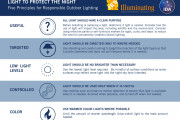 2020-04-21
2020-04-21
The Illuminating Engineering Society (IES) and the International Dark-Sky Association (IDA) announced a strategic collaboration to address the global issue of light pollution that negatively affects our environment and the human condition.
The two parties adopted Five Principles for Responsible Outdoor Lighting and seek to guide the outdoor lighting industry in the U.S. and beyond to be more socially and environmentally responsible. The five principles addressed that light at night should be with clear purpose and used in necessary areas in low level and warmer colo...
Continue reading →
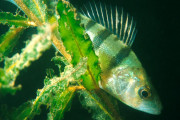 2020-04-08
2020-04-08
Environmental scientists at IGB, The Leibniz-Institute of Freshwater Ecology and Inland Fisheries, the research institute in Germany, found that artificial lighting at night affects melatonin reproduction in fishes.
It is widely acknowledged that melatonin plays a critical role in regulating circadian rhythm of human bodies. And a research team now proved that lighting also suppresses production of melatonin in fishes. The team of IGB researchers investigated melatonin production in European perch and showed that light pollution, like nighttime urban sky glow, is bright...
Continue reading →
2019-12-23
Researchers from Leibniz-Institute of Freshwater Ecology and Inland Fisheries (IGB) in an international team have analyzed data on the impact of light pollution on melatonin formation in humans and vertebrates. They found that even the low light intensities of urban skyglow can suppress melatonin production.
Melatonin synchronizes the day-night-rhythm in animals and humans. It adjusts the circadian clocks of cells, tissues and organs, and regulates other seasonal processes like reproduction. In vertebrates, differences in light levels are detected by photoreceptors for examp...
Continue reading →
 2019-04-22
2019-04-22
The impacts of artificial light on wildlife have been a study focus for biodiversity researchers. On Earth Day, let’s look into how different street lights affect bats activities.
A team at the Leibniz Institute for Zoo and Wildlife Research (Leibniz-IZW) has conducted a study to find out how UV emitting and non-UV emitting street lamps influence the activity of bats in the Berlin metropolitan area and whether tree cover might mitigate any effect of light pollution. The study is published in the scientific journal “Frontiers in Ecology and Evolution.&rdq...
Continue reading →
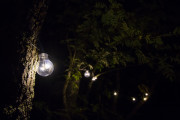 2019-02-25
2019-02-25
People are becoming more aware of the effects of artificial lighting on the human body and wildlife, especially the impacts of lighting at night. A new study led by researchers from Newcastle and York universities found that street lights may disrupt plant pollination as they attract moths; however, by switching off street lights for part of the night, the interruption can be minimized.
Apart from bees, moths also play an important role in the pollination of plants to supplement the day-time work of bees and other pollinating insects. These night-time pollinators are critical even f...
Continue reading →
 2017-11-28
2017-11-28
A recent study led by Christopher Kyba from the GFZ German Research Centre shows artificially lit outdoor surfaces grew at an annual rate of 2.2% between 2012 and 2016. The fact that the world is transitioning to LED lighting so as to run away from pollution caused by traditional lighting is raising another type of environmental concern— light pollution.
Continue reading →
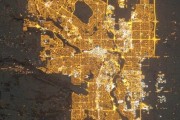 2017-11-24
2017-11-24
Municipalities, enterprises, and households are switching to LED lights in order to save energy. But these savings might be lost if their neighbours install new or brighter lamps.
Continue reading →
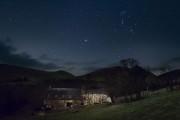 2017-04-25
2017-04-25
The Brecon Beacons National Park, one of the three national parks in Wales, UK, has earned special protection of its night sky from light pollution and is an ideal place for stargazing. However, for the sake of safety, the Welsh Government recently installed LED street lights in Cwmdu, Powys, leaving a campaign group concerned.
Continue reading →
2014-12-29
Honolulu and the Canadian city of Calgary are reported to replace sodium-vapor streetlights with energy saving LEDs, according to a news report by HNGN.
Continue reading →
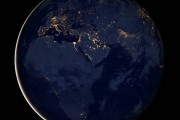 2014-12-26
2014-12-26
Many people don't know that there’s more to scientist Isaac Newton than a certain apple falling from a tree. Holding a prism of glass in the path of sunlight, he showed that white light is actually made up of seven different colors – red, orange, yellow, green, blue, indigo, and violet. Color comes from light – in fact, color is light.
Continue reading →
2014-10-22
Access Fixtures is proud to announce new LED amber flood lights as part of its comprehensive line of wildlife-friendly luminaires. In many areas, especially coastal communities, excessive artificial lighting can harm wildlife, like sea turtles that need a dark sky to orient towards the ocean. For this reason, many local ordinances require wildlife-friendly lighting. Access Fixtures LED amber flood lights and area lights are visible to humans, but not to most species affected by artificial lighting. The flood lights are ideal for a number of applications, including parking lot lighting, area lighting, park lighting, marinas, landscape lighting and roadway lighting.
Continue reading →
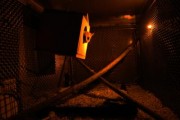 2014-07-03
2014-07-03
Besides obscuring the stars, light pollution can also disrupt the reproduction of light-sensitive animals. French scientists have shown that light pollution can override the natural reproductive cycle of some animals, making them sexually active out of season.
Continue reading →
 2020-04-21
2020-04-21
 2020-04-08
2020-04-08
 2019-04-22
2019-04-22
 2019-02-25
2019-02-25
 2017-11-28
2017-11-28
 2017-11-24
2017-11-24
 2017-04-25
2017-04-25
 2014-12-26
2014-12-26
 2014-07-03
2014-07-03